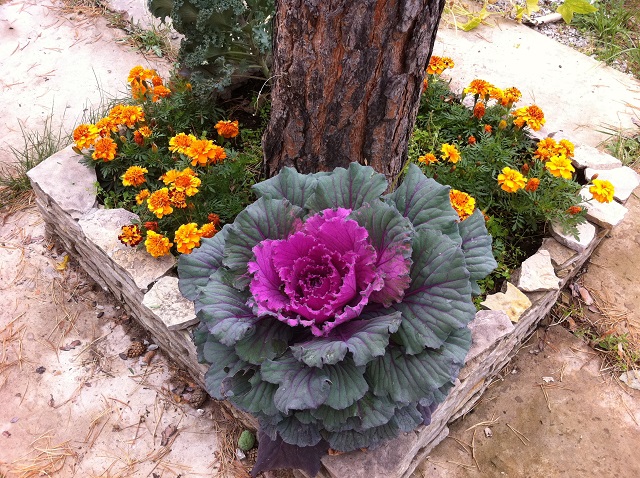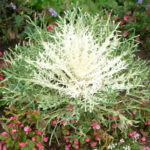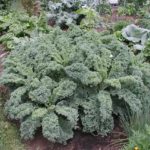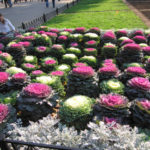Ornamental cabbage or, as it is also called, the ornamental princess is a unique flower with which you can decorate your garden or flower bed. The extraordinary beauty of the plant allows it to become the highlight of the site. If you properly organize the location of cabbage in the flower garden, you can be sure that the design of the flower bed will be stunning. In this article we will explain how to plant a colored vegetable and carry out the subsequent care of it.
Table of contents
Decorative cabbage: flower or vegetable?
Ornamental cabbage is a biennial plant, which, in fact, combines several kinds of kale. In the first year of its life, it amazes with its chic appearance. In the second year of life, its active flowering and the appearance of fruits begin.
A variety of varieties that belong to this group of cruciferous culture, will allow anyone to find a plant that satisfies all his taste preferences. The height of the flower varies from 25 cm to 120 cm. Cabbage leaves can be of various shapes and shades. The most advantageous look elliptical and ovoid shape. The color palette of the plant has a huge number of tones from pale white to bright purple.
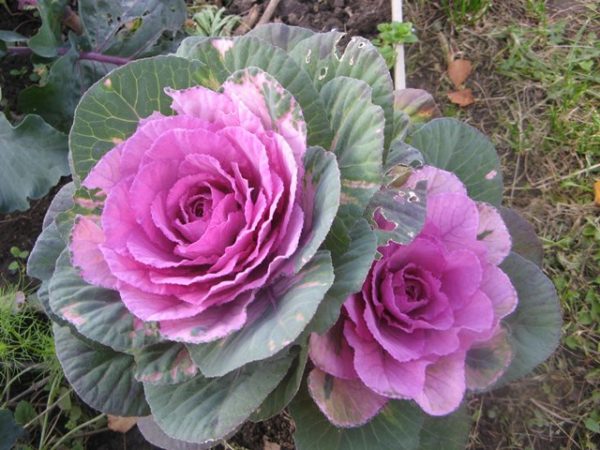
Is it possible to eat a decorative vegetable?
Most varieties of cabbage are edible. Red and white type of leafy plants (Nagoya) are distinguished by juicy and tender leaves, which are often grown for sale for the preparation of a side dish.Also excellent taste have varieties of plants with fringed leaves.
Rinse them under running water. You can not soak in water for a long time, as the cruciferous culture will lose its beneficial properties. Experts advise instead of washing pour the leaves with boiling water. Lightly folded leaflet can be used in moments of cooking soup-puree.
Popular varieties for growing
Each of the varieties of ornamental cabbage has a unique appearance. The most popular varieties of plants for growing in their own flower bed should include:
- Lace jabot - a view that combines several colors that perfectly complement each other. The corrugated leaflets are identical to the folded jabot. A characteristic feature of this variety are light outlines and crisp lace. The plant reaches 50 cm in height.
- Peacock F1 - variety with a diverse palette of colors, while maintaining the clarity of borders. The cabbage is 70 cm in diameter, and its height does not exceed 35 cm. The leaves located in the lower part are colored in green,and the upper stems can be white, red or pink. The structure of the leaves is very similar to peacock feathers.
- Russian circle - cabbage of incredible beauty that can resemble flowers of various varieties and types. Compact plant can be of any color.
- Lark tongue - the classic type of cruciferous culture, which has a green tint and several similar pigments. The leaves of culture have similarity of hanging languages, which seem to want to rise to the heavens. The plant can reach 85-90 cm in height.
- Coral Queen - the main feature of this variety is a specifically thin cut of leaves. The culture form resembles growing coral in the midst of marine vegetation. The leaves are painted in light red hues.
- Piglon - a flower resembling a luxurious rose. The colors of the sockets in most cases are creamy white, however, there are other light colors.
- Coral quin
- Peacock F1
- Piglon
- Russian circle
- Lark tongue
Landing rules in the garden or at the cottage
You can grow decorative cabbage seedlings using seeds. Seedlings can be sown in:
- containers;
- greenhouses;
- open ground.
Sowing in containers
Picking up small containers, we sow a pair of seeds in each of them. As a rule, embedment into the soil is carried out to a depth of 1 cm. Preliminary, it is recommended to treat the soil with a fungicide, which will prevent the appearance of the black stem in seedlings.
After the appearance of seedlings, it should be moved to a cooler room. Watering exercise moderately. When the second leaf appears, it is necessary to feed the seedlings. For this it is best to use Kemira Universal. For each sq.m. need a spoon (st.) fertilizer.
Towards the beginning of May, shoots should be planted in open ground. As a rule, during this period each plant has about 5 leaves. If desired, you can initially sow the seedlings in the garden, and closer to the end of August to transplant in a flower bed.
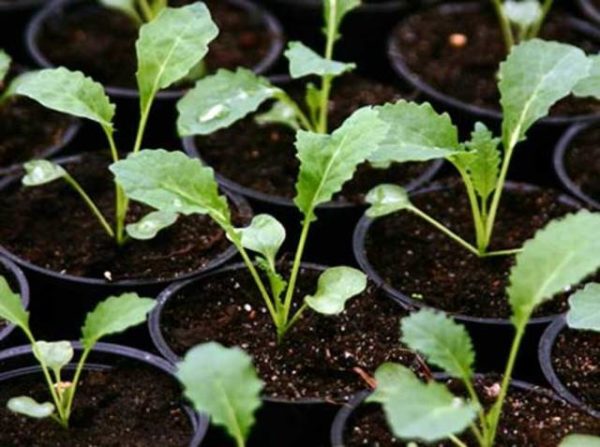
Sowing in the greenhouse
Before planting a plant in a greenhouse, it is necessary to prepare a soil mixture based on sand, peat, and garden land (proportion 2: 1: 2). Layer of soil mixture should reach about 12-15 cm.Before sowing, the soil is treated with a solution of potassium permanganate, which will prevent the occurrence of a fungal infection in the future.
Seeds should be laid in small dimples (about 1 cm) in the amount of 2 pieces. and lightly sprinkled with well-fluffy ground. DTo accelerate the germination of crops covered with film. The temperature in the greenhouse should be within 20 degrees. As soon as the first shoots appear, the temperature will drop to 12 degrees. The seedlings are watered moderately, and the soil is loosened out of necessity.
Sowing in open ground
This method allows you to grow a plant that is hardened and resistant to temperature changes. The ideal period for planting seeds is mid-April. Before the emergence of seedlings sown place covered with film.
Seeds are sown in the loosened soil, closing them up 1.5 cm in depth. As soon as shoots appear, crops should be thinned, leaving stronger flowers. The seedlings are transplanted to a permanent place after 30-40 days.
Timely care of the plant will allow you to get a large-shaped lace rosettes.
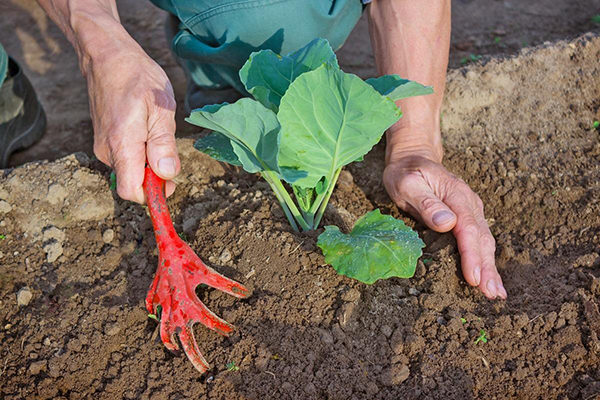
Care
Caring for decorative cabbage is easy.It is important to regularly:
- water;
- weed beds from weeds;
- feed the soil;
- loosen up
After 2 weeks after transplanting the plant to a permanent place, it is necessary to start feeding the young shoots. For these purposes, use urea and diluted mullein. It is better to select the proportion for dressing from the consideration of a liter capacity of mullein per 10 liters of water. This will provoke an intense foliage formation.
The following feeding, as a rule, is carried out 14 days after the first. To do this, use mineral fertilizers. Once each of the bushes will form about 10 leaves, you can begin to loosen the ground around the flowers.
Use on flowerbeds in landscape design
Cabbage varieties, resembling the shape of a rose, are often used to create flower beds, rabatok and borders. In this case, it is desirable to plant them next to annual plants. Also, flowers are successfully settled in the place of faded spring flowers. An ornamental plant is well tolerated by several transplants, it can even bloom with the onset of frost.
The flower perfectly transfers not only frosts, but also a bitter cold at a temperature of -12, -14 degrees. The main advantage of planting decorative cabbage in flowerbeds is considered to be cost-effectiveness. One plant takes up almost 50 cm of space, so it is ideal for owners of large areas.
- Flowerbed with cabbage and other herbs
- Planting decorative cabbage in pots and pots
- Decorative cabbage on the sides of the walkway
- Boxes with decorative cabbage by the window
- Decorative cabbage with an arrow on the flowerbed
- Planting ornamental cabbage herringbone
- Decorative cabbage in lawn design
Diseases and pests
Decorative cabbage love cabbage flies. In order to protect your flowers you need to make special collars out of paper. Cut circles from paper, the diameter of which will be approximately 10 cm. We cut their edges to the center along straight lines. We pass stalks through the cuts and wrap the flowers tightly. As soon as the seedlings gain strength, you can remove the paper collars.
Ornamental cabbage is subject to certain diseases, namely:
- fomoz;
- kela;
- root system diseases.
Observing all the recommendations of experts, you can decorate your own site and give it a zest. Especially gorgeous plant looks after the onset of frost. Rime on the leaves gives them a certain crystal, and between the leaves of the leaves shine in the sun like diamonds.
